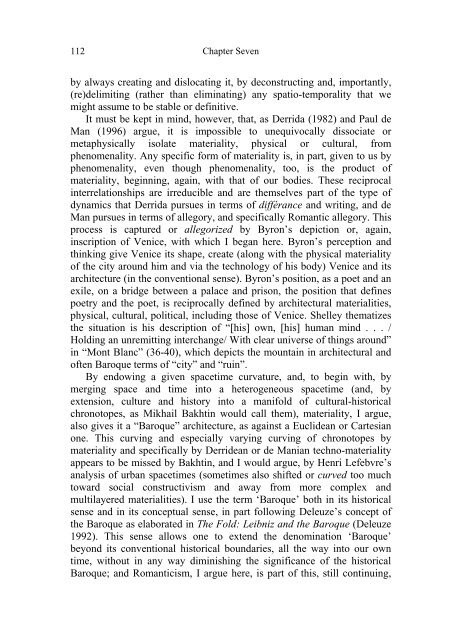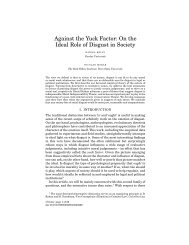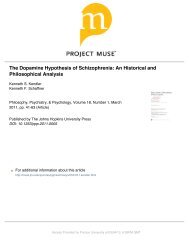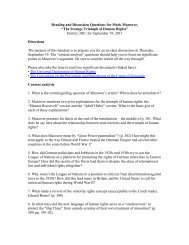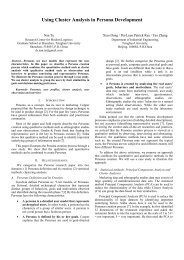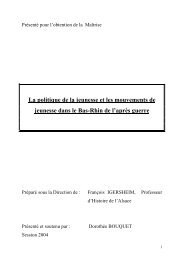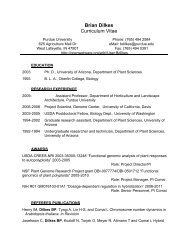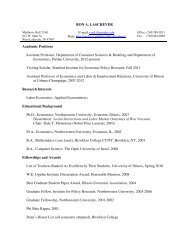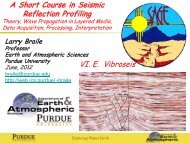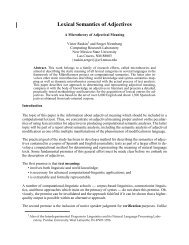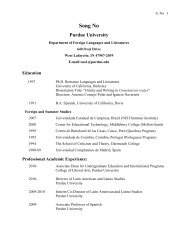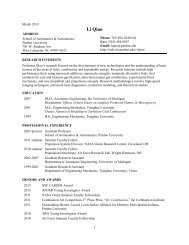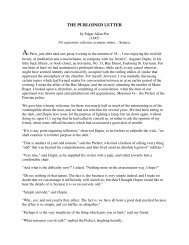'a palace and a prison on each hand': venice between madness and ...
'a palace and a prison on each hand': venice between madness and ...
'a palace and a prison on each hand': venice between madness and ...
You also want an ePaper? Increase the reach of your titles
YUMPU automatically turns print PDFs into web optimized ePapers that Google loves.
112<br />
Chapter Seven<br />
by always creating <str<strong>on</strong>g>and</str<strong>on</strong>g> dislocating it, by dec<strong>on</strong>structing <str<strong>on</strong>g>and</str<strong>on</strong>g>, importantly,<br />
(re)delimiting (rather than eliminating) any spatio-temporality that we<br />
might assume to be stable or definitive.<br />
It must be kept in mind, however, that, as Derrida (1982) <str<strong>on</strong>g>and</str<strong>on</strong>g> Paul de<br />
Man (1996) argue, it is impossible to unequivocally dissociate or<br />
metaphysically isolate materiality, physical or cultural, from<br />
phenomenality. Any specific form of materiality is, in part, given to us by<br />
phenomenality, even though phenomenality, too, is the product of<br />
materiality, beginning, again, with that of our bodies. These reciprocal<br />
interrelati<strong>on</strong>ships are irreducible <str<strong>on</strong>g>and</str<strong>on</strong>g> are themselves part of the type of<br />
dynamics that Derrida pursues in terms of différance <str<strong>on</strong>g>and</str<strong>on</strong>g> writing, <str<strong>on</strong>g>and</str<strong>on</strong>g> de<br />
Man pursues in terms of allegory, <str<strong>on</strong>g>and</str<strong>on</strong>g> specifically Romantic allegory. This<br />
process is captured or allegorized by Byr<strong>on</strong>’s depicti<strong>on</strong> or, again,<br />
inscripti<strong>on</strong> of Venice, with which I began here. Byr<strong>on</strong>’s percepti<strong>on</strong> <str<strong>on</strong>g>and</str<strong>on</strong>g><br />
thinking give Venice its shape, create (al<strong>on</strong>g with the physical materiality<br />
of the city around him <str<strong>on</strong>g>and</str<strong>on</strong>g> via the technology of his body) Venice <str<strong>on</strong>g>and</str<strong>on</strong>g> its<br />
architecture (in the c<strong>on</strong>venti<strong>on</strong>al sense). Byr<strong>on</strong>’s positi<strong>on</strong>, as a poet <str<strong>on</strong>g>and</str<strong>on</strong>g> an<br />
exile, <strong>on</strong> a bridge <strong>between</strong> a <str<strong>on</strong>g>palace</str<strong>on</strong>g> <str<strong>on</strong>g>and</str<strong>on</strong>g> <str<strong>on</strong>g>pris<strong>on</strong></str<strong>on</strong>g>, the positi<strong>on</strong> that defines<br />
poetry <str<strong>on</strong>g>and</str<strong>on</strong>g> the poet, is reciprocally defined by architectural materialities,<br />
physical, cultural, political, including those of Venice. Shelley thematizes<br />
the situati<strong>on</strong> is his descripti<strong>on</strong> of “[his] own, [his] human mind . . . /<br />
Holding an unremitting interchange/ With clear universe of things around”<br />
in “M<strong>on</strong>t Blanc” (36-40), which depicts the mountain in architectural <str<strong>on</strong>g>and</str<strong>on</strong>g><br />
often Baroque terms of “city” <str<strong>on</strong>g>and</str<strong>on</strong>g> “ruin”.<br />
By endowing a given spacetime curvature, <str<strong>on</strong>g>and</str<strong>on</strong>g>, to begin with, by<br />
merging space <str<strong>on</strong>g>and</str<strong>on</strong>g> time into a heterogeneous spacetime (<str<strong>on</strong>g>and</str<strong>on</strong>g>, by<br />
extensi<strong>on</strong>, culture <str<strong>on</strong>g>and</str<strong>on</strong>g> history into a manifold of cultural-historical<br />
chr<strong>on</strong>otopes, as Mikhail Bakhtin would call them), materiality, I argue,<br />
also gives it a “Baroque” architecture, as against a Euclidean or Cartesian<br />
<strong>on</strong>e. This curving <str<strong>on</strong>g>and</str<strong>on</strong>g> especially varying curving of chr<strong>on</strong>otopes by<br />
materiality <str<strong>on</strong>g>and</str<strong>on</strong>g> specifically by Derridean or de Manian techno-materiality<br />
appears to be missed by Bakhtin, <str<strong>on</strong>g>and</str<strong>on</strong>g> I would argue, by Henri Lefebvre’s<br />
analysis of urban spacetimes (sometimes also shifted or curved too much<br />
toward social c<strong>on</strong>structivism <str<strong>on</strong>g>and</str<strong>on</strong>g> away from more complex <str<strong>on</strong>g>and</str<strong>on</strong>g><br />
multilayered materialities). I use the term ‘Baroque’ both in its historical<br />
sense <str<strong>on</strong>g>and</str<strong>on</strong>g> in its c<strong>on</strong>ceptual sense, in part following Deleuze’s c<strong>on</strong>cept of<br />
the Baroque as elaborated in The Fold: Leibniz <str<strong>on</strong>g>and</str<strong>on</strong>g> the Baroque (Deleuze<br />
1992). This sense allows <strong>on</strong>e to extend the denominati<strong>on</strong> ‘Baroque’<br />
bey<strong>on</strong>d its c<strong>on</strong>venti<strong>on</strong>al historical boundaries, all the way into our own<br />
time, without in any way diminishing the significance of the historical<br />
Baroque; <str<strong>on</strong>g>and</str<strong>on</strong>g> Romanticism, I argue here, is part of this, still c<strong>on</strong>tinuing,


